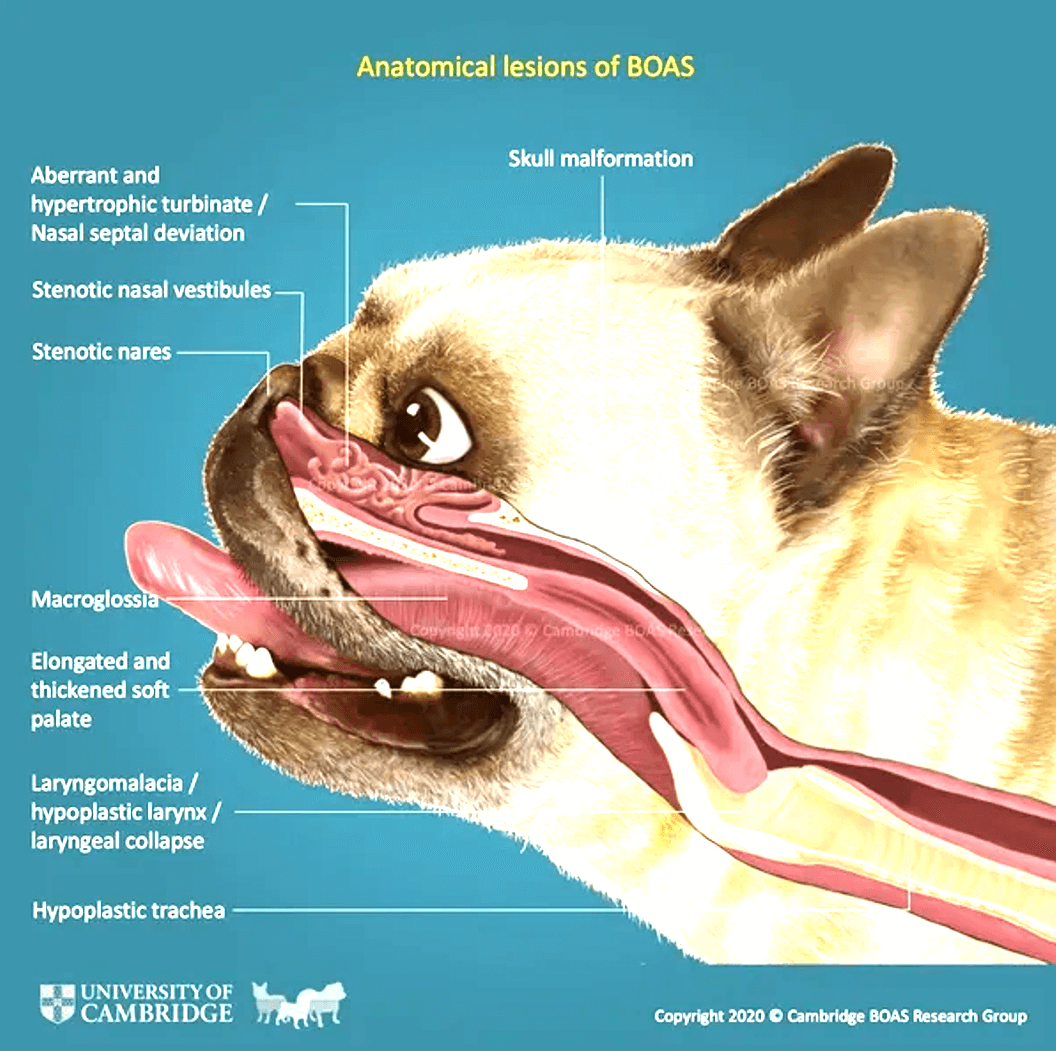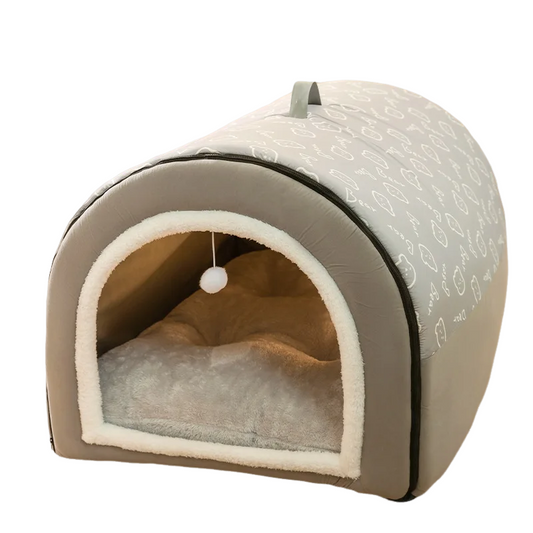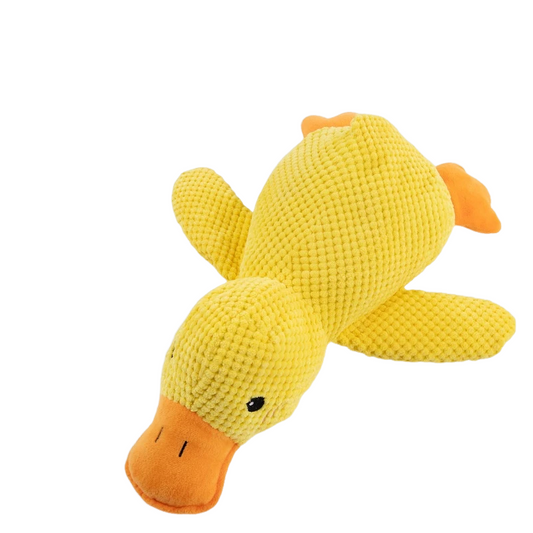
Brachycephalic Obstructive Airway Syndrome (BOAS) in Dogs: Causes, Symptoms, and Treatment
Share
Introduction
Brachycephalic Obstructive Airway Syndrome (BOAS) is a significant and often misunderstood respiratory condition affecting brachycephalic dogs—those breeds with short noses and flat faces. This condition primarily affects breeds such as French Bulldogs, Boston Terriers, Pugs, and English Bulldogs. These dogs are beloved for their distinctive facial features, but those features come with serious health implications, particularly in the respiratory system. Understanding BOAS, its causes, symptoms, and treatment options is crucial for ensuring the well-being of these unique dogs.
1. Why Are Brachycephalic Dogs Prone to Respiratory Issues?
The charmingly flat faces of brachycephalic dogs result from a shortened skull structure, but this also means their airways are often compressed and distorted. Unlike breeds with longer muzzles, brachycephalic dogs have less room for essential respiratory structures like the nasal passages, soft palate, and trachea. As a result, these dogs experience restricted airflow, making it difficult for them to breathe, especially during physical exertion or in hot weather. These anatomical challenges are the primary causes of BOAS, leading to various degrees of breathing difficulties.

2. Key Structural Problems Contributing to BOAS
BOAS is primarily a structural issue, and several anatomical features in brachycephalic dogs contribute to the syndrome:
Stenotic Nares (Narrow Nostrils): One of the most noticeable issues in brachycephalic breeds is their narrow nostrils. This condition, known as stenotic nares, severely restricts the airflow through the nose, forcing the dog to rely on mouth breathing, which is less efficient and can lead to further complications.
Elongated Soft Palate: The soft palate, which separates the nasal cavity from the oral cavity, is often elongated in brachycephalic dogs. This can cause it to obstruct the entrance to the trachea, particularly during physical activities or even while eating, making breathing more laborious.
Hypoplastic Trachea (Narrow Trachea): Brachycephalic dogs often have a trachea that is smaller in diameter than normal, further complicating the airflow to the lungs. This narrowed trachea can lead to chronic respiratory issues and increases the effort required for breathing.
Everted Laryngeal Saccules: Located just inside the larynx, these small sacs can become swollen and evert (turn outward), further narrowing the already constricted airways in these dogs. This condition can exacerbate breathing difficulties, especially during exercise or stressful situations.
Large Tongue and Enlarged Tonsils: Brachycephalic dogs often have disproportionately large tongues and swollen tonsils, which can further reduce the space in the mouth and throat, leading to more pronounced breathing difficulties.
3. Common Symptoms of BOAS and How to Identify Them
BOAS can present a wide range of symptoms, and its severity can vary greatly among individual dogs. Pet owners should be aware of the following signs:
-
Noisy Breathing and Snoring: Dogs with BOAS often have loud, labored breathing, even at rest. Snoring is common, and some dogs may exhibit stridor, a high-pitched wheezing sound during breathing.
-
Exercise Intolerance: Brachycephalic dogs affected by BOAS may struggle to engage in prolonged physical activity. They often tire quickly, pant excessively, and may collapse from overexertion, even after minimal exercise.
-
Gagging and Coughing: Due to the obstruction in their airways, these dogs may frequently gag, cough, or retch, particularly after eating, drinking, or physical exertion.
-
Heat Sensitivity: BOAS-affected dogs are at a higher risk of heatstroke, as their compromised breathing makes it difficult to regulate body temperature. Even mild weather can pose a threat, making it essential for owners to be vigilant in warm conditions.
-
Cyanosis: In severe cases, a dog’s gums and tongue may appear bluish due to a lack of oxygen—a condition known as cyanosis. This is a medical emergency and requires immediate veterinary attention.


4. The 25/30 Experiment: A Simple Test to Assess BOAS
To evaluate the severity of BOAS in your brachycephalic dog, you can perform the "25/30 experiment." This experiment involves allowing your dog to exercise for 30 minutes in a 25°C (77°F) environment. After the exercise, compare their panting intensity and the time it takes for their breathing to return to normal with that of a dog with a normal muzzle length. Research indicates that while a normal dog might take around 9 minutes to recover, a brachycephalic dog could take upwards of 22 minutes. This simple test can provide valuable insights into how BOAS affects your dog’s daily life.
5. Diagnosing BOAS: What to Expect at the Vet
If your dog shows signs of BOAS, a veterinary evaluation is essential. Diagnosis usually begins with a thorough physical examination, focusing on the dog’s breathing patterns and respiratory sounds. Vets may also recommend diagnostic imaging, such as X-rays, CT scans, or endoscopy, to assess the internal structure of the airways. In some cases, vets might conduct a laryngeal examination under sedation to evaluate the extent of the obstruction.
6. Treatment Options for BOAS: From Management to Surgery
Treating BOAS can vary depending on the severity of the condition. For mild cases, management strategies may suffice, while more severe cases might require surgical intervention.
Non-Surgical Management of BOAS
-
Weight Control: Obesity can exacerbate BOAS symptoms by putting additional pressure on the respiratory system. Maintaining a healthy weight through a balanced diet and appropriate exercise is crucial for reducing the severity of symptoms.
-
Exercise Modification: Limit your dog's physical activities, especially in hot and humid weather. Short, slow walks during the cooler parts of the day are ideal. Always monitor your dog for signs of distress, such as excessive panting or difficulty breathing.
-
Cooling Strategies: Brachycephalic dogs are particularly vulnerable to heat, so keeping them cool is essential. Ensure they have access to air conditioning or fans in warm weather, and consider using cooling mats or vests to help regulate their body temperature.
-
Avoid Stressful Situations: Stress can worsen BOAS symptoms, so it's essential to keep your dog calm and avoid situations that may trigger anxiety or excitement.
-
Regular Veterinary Checkups: Routine checkups with your veterinarian are crucial for monitoring your dog’s condition and adjusting the management plan as needed.
Surgical Options for BOAS
For dogs with moderate to severe BOAS, surgery may be the most effective treatment. Common surgical procedures include:
-
Stenotic Nares Correction (Nasal Widening): This surgery involves widening the nostrils to improve airflow through the nasal passages, making breathing easier for the dog.
-
Soft Palate Resection: In this procedure, a portion of the elongated soft palate is removed to reduce airway obstruction and allow for more efficient breathing.
-
Laryngeal Saccule Resection: For dogs with everted laryngeal saccules, removing the swollen tissue can help open up the airway and alleviate breathing difficulties.
-
Tonsillectomy: In some cases, removing enlarged tonsils can also improve airflow and reduce respiratory distress.
Veterinarians often recommend performing these surgeries when the dog is between 8-14 months old, as this age range offers the best balance between surgical risk and long-term benefits. Surgery at this stage is also commonly performed alongside spaying or neutering, minimizing the need for multiple anesthetic events.
7. Living with a BOAS-Affected Dog: Long-Term Care and Considerations
Owning a brachycephalic dog with BOAS requires ongoing care and vigilance. While surgery can significantly improve their quality of life, not all dogs are candidates for these procedures due to financial or health constraints. For those dogs, effective management is key to ensuring their comfort and well-being.
Daily Care Tips for BOAS-Affected Dogs
-
Monitor Breathing Regularly: Keep a close eye on your dog's breathing patterns. Any sudden changes, increased effort, or signs of distress should prompt an immediate visit to the vet.
-
Prevent Overheating: During warmer months, prioritize keeping your dog cool. Avoid outdoor activities during peak heat, and always provide plenty of water and shade.
-
Regular Grooming: Proper grooming can help keep your dog cool and reduce the risk of skin infections, which are common in brachycephalic breeds due to their skin folds.
-
Supportive Accessories: Consider using a harness instead of a collar, as it reduces pressure on the dog's neck and airway, making walks more comfortable.
-
Educate Yourself: Stay informed about BOAS and potential complications by keeping up with the latest veterinary advice and research.

Conclusion: Understanding and Managing BOAS
Brachycephalic Obstructive Airway Syndrome (BOAS) presents unique challenges for both dogs and their owners. However, with the right knowledge and proactive care, many of these dogs can lead fulfilling lives. Whether through careful





